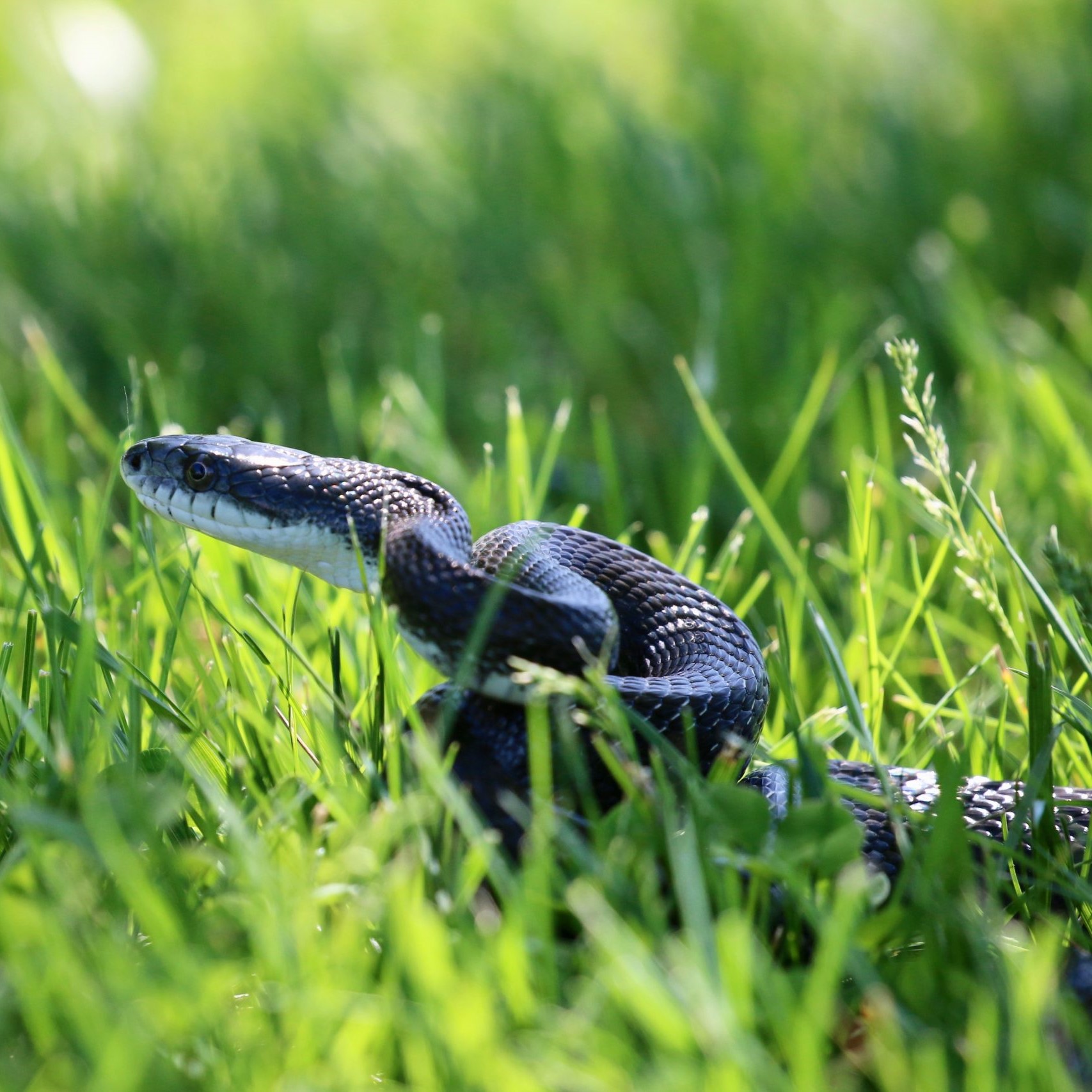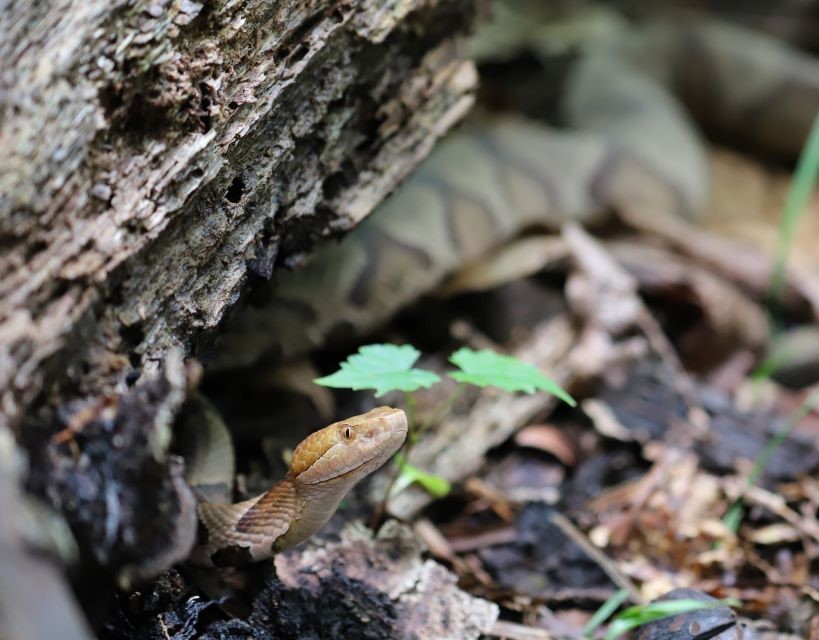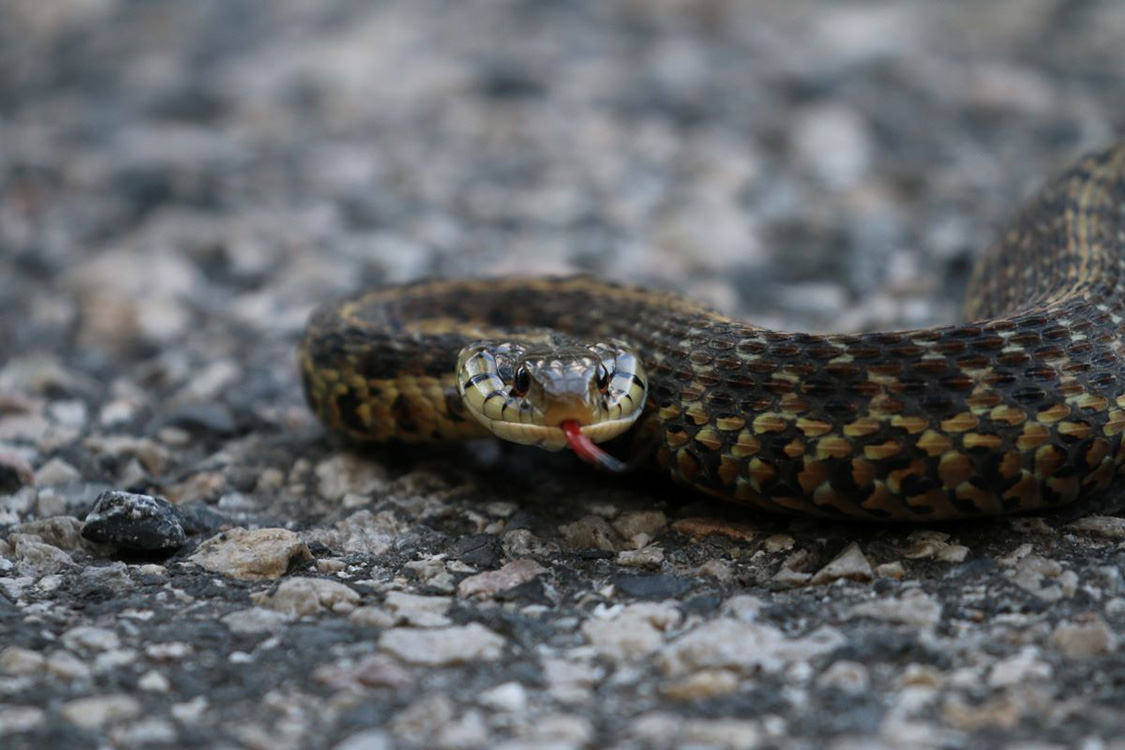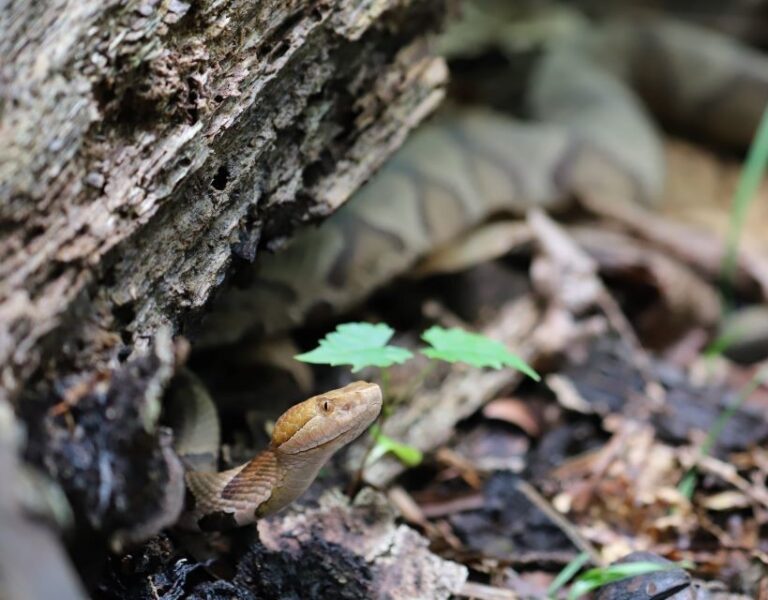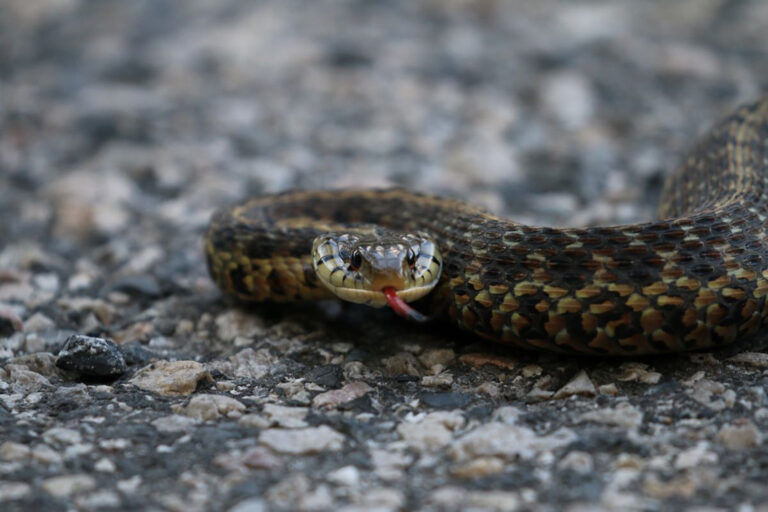Snakes play valuable roles in their native environments. As predators, snakes play an important factor through the food web, and often keep prey numbers in check. Snakes feed on rodents, birds, bird eggs, frogs, insects, and even other snakes. Even so, snakes are sometimes prey species themselves and provide food for higher predators, such as hawks, herons, skunks and raccoons etc.
As the weather improves through the spring and summer, the chance of encountering snakes increases. Rising temperatures bring people outside, and snakes can often be seen in parks, yards and around homes. When encountered, often non-venomous snakes are mistaken for their venomous counterparts and can create unnecessary fears. Education about these creatures is very important for people and for snakes, themselves. Understanding differences between venomous and non-venomous snakes is a key component to education and can dispel fear and anxiety about these valuable critters.
A Few Common Non-Venomous Snakes
Eastern Rat Snake (aka Black Rat Snake)
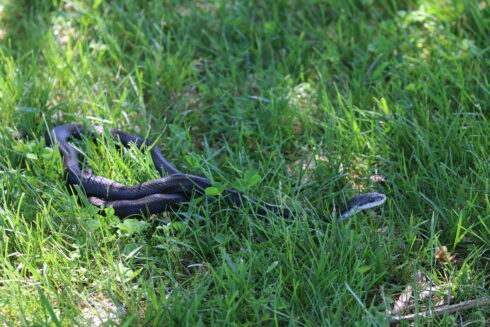
The Eastern Rat Snake (or commonly referred to as Black Rat Snake) is the largest snake in Montgomery County, growing up to 6 feet (sometimes larger) in length as an adult. Adults can be identified by their plain, shiny black body with their belly having an irregular black and white checkerboard pattern. The chin and throat are typically a cream or white color.
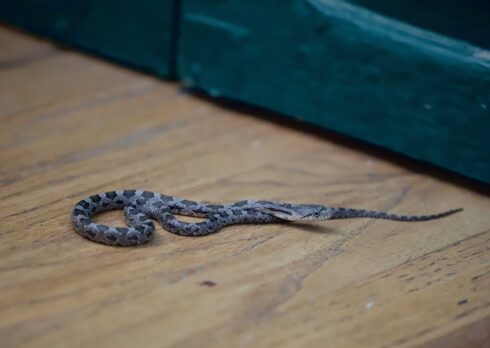
Juvenile Eastern Rat Snakes can be distinguished from the adults with their strong pattern of grey and brown blotches on their pale grey back. Juveniles are often mistakenly identified as Eastern Copperheads. One key feature to compare a juvenile Eastern Rat Snake from a juvenile copperhead is the sulfur yellow colored tail that juvenile copperheads possess.
Eastern Rat Snakes are found in a variety of habitats, including farmlands, hardwood forests, forested wetlands, urban woodlots and backyards. They are notorious climbers, as they are often seen climbing up and down trees and even the sides of human structures in search of food and shelter. In some cases, they can find their way into attics, basements and crawlspaces undetected.
Northern Watersnake
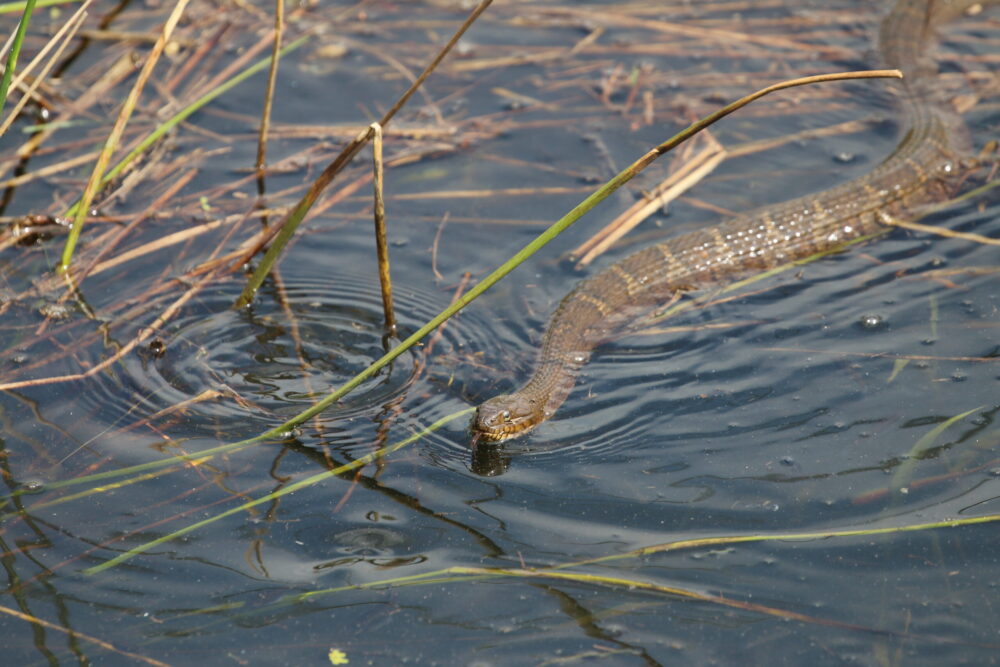
Northern Watersnakes have a large rounded head and a back pattern of black to reddish-brown blotches, which may form crossbands. They can grow to almost 4 feet in length. They are excellent swimmers and can be found in nearly every type of wetland habitat, from rivers to lakes to ponds. They are often seen basking on rocks on the shorelines of creeks and ponds.
These snakes are non-venomous but can be aggressive. They readily strike and bite. When they feel threatened, they will release a foul- smelling musk as a defense mechanism. Often, watersnakes can be mistakenly identified as the venomous Northern Copperhead due to the patterning and bands on the body. It is important to remember that there are some key features to help identify whether a snake is venomous or not. These features are described below on page 8. Watersnakes can also be mistaken for the venomous Water Moccasin, which are not known to live in Maryland.
Eastern Garter Snake
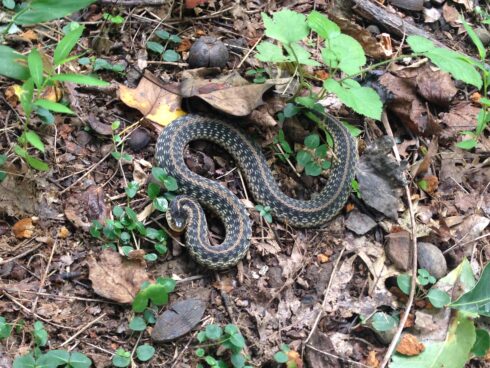
Eastern Garter Snakes can be identified by their distinct yellow or white strip down the center of their back. The rest of their back has a greenish brown or black checkerboard pattern. The belly is cream to yellow-green, and generally unmarked. They grow to 1-2 feet in length. They are relatively common to see, especially during the day. They can be found in the forest, old fields, riparian areas and backyards. These snakes are non-venomous, but they can be fairly aggressive. Like all snakes, they will readily strike. When they feel threatened, they will release a foul-smelling musk as a defense mechanism.
Eastern Milk Snake
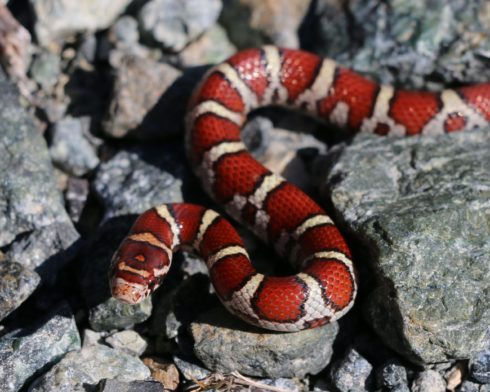
The Eastern Milk Snake is slender with a body color of tan to light brown and broad red with black-bordered blotches down the body. At the nape of the neck, there is a grey or tan Y-, V-, U- or A- shaped patch. The belly has a black and white checkboard pattern. They can grow up to 3 feet in length.
Sometimes, these non-venomous snakes can be mistakenly identified as the venomous Northern Copperhead due to the patterning and bands on the body. It is important to remember that there are some key features to help identify whether a snake is venomous or not (see page 8).
Eastern Milk Snakes can be found in a variety of habitats, from the forests to rocky outcrops to open fields to human structures. The chances of encountering one is slim because they are primarily nocturnal and burrow.
Venomous Snakes
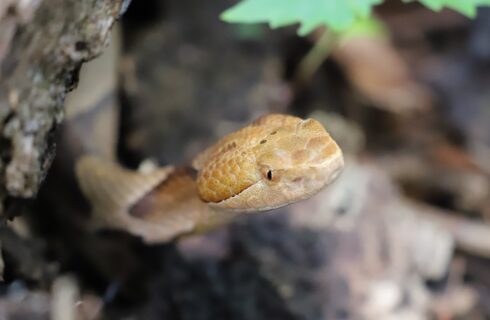
Maryland is home to two venomous snakes: Eastern Copperhead and Timber Rattlesnake. While Timber Rattlesnakes are native to Maryland, they are not historically found in Montgomery County. They typically are only found in the western part of the state from Frederick to Garrett Counties.
There are some key features to help identify whether a snake is venomous or not. Both of Maryland’s native venomous snakes have elliptical shaped pupils, similar to that of a cat, whereas the native non-venomous snakes have round pupils similar to humans. The venomous snakes also have a pit sensor below their eyes, which is a separate opening on their snout from their nostrils (these snakes are collectively also known as “pit vipers”). The shape and size of the head can also help you distinguish between those which are venomous and nonvenomous. Venomous snakes have wider heads, and they often resemble a triangle. This can sometimes be difficult to notice, especially on smaller snakes. Please note that these identification features apply to the native snakes of Maryland and may not hold true for venomous snakes from other areas of the world
Eastern Copperhead
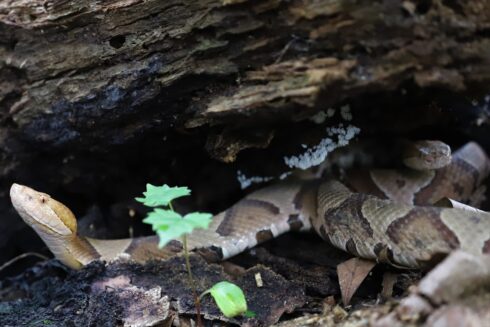
Eastern Copperheads typically have a tan to brown colored body with a copper-red colored head. They can be identified by the darker chestnut brown colored hourglass pattern crossbands along the entire body. Like most venomous snakes, they have elliptical shaped pupils in their eyes, facial pit sensors below the eyes and a triangular shaped head.
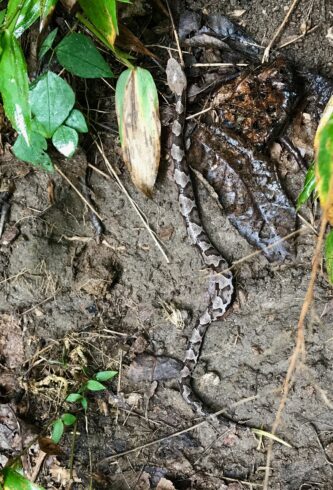
Juvenile Copperheads are distinguished by a sulfur yellow colored tail. This feature is most important when comparing to other similar looking snakes, such as a juvenile Eastern Rat Snake. The sulfur yellow tail fades over time as they grow into adults.
As noted above, Copperheads are pit vipers. Pit vipers have a heat- sensitive pit organ on each side of its head between the eye and the nostril. The pits help detect objects that are warmer than the environment and allow copperheads to locate prey. When prey is detected, copperheads will ambush and subdue the prey by injecting it with venom using their fangs. Newborn and juvenile copperheads have fully functional fangs that are capable of injecting venom as toxic as an adult’s.
Copperheads are most active during the spring and summer months as they emerge from winter hibernation and prepare for mating season. Mating season is usually from April to May, but they can mate again in September. Copperheads hibernate over the winter from November to April but can emerge on the warmer days to bask in the sun.
While Copperheads are not aggressive by nature, and would prefer to remain undetected, they will strike when threatened, stepped on or handled. They can be difficult to see because they rely on camouflage for protection. Though the copperhead is the cause of some snakebites annually, those bites are rarely fatal. However, they are extremely painful.
What to do if you encounter snakes
- DO NOT KILL OR HARM SNAKES. All native snakes of Maryland are protected by state law and may not be killed, possessed, bred or sold.
- Admire and respect snakes from a safe distance
- Do not attempt to capture and handle snakes, especially if you’re unsure of the species. Any snake will readily bite if provoked
- Minimize any disturbance to snakes
- Stay on designated trails and always look where you step. Use caution when stepping over logs and woody
- Always keep pets on a leash when utilizing
Non-venomous snakes are commonly misidentified as their venomous counterparts. Remember the key features to look for to help you identify and protect yourself:
- Elliptical shaped pupils (similar to cats)
- Pit sensor (small opening) below eyes
- Triangular shaped head
Look for these features, at a safe distance. It can help distinguish between whether a snake is venomous or nonvenomous. If you’re unsure of the species, take a photograph of it from a safe distance and contact Montgomery Parks Wildlife Ecology Unit (phone 301-962-1341 or email) or other wildlife professional. Copperhead bites are extremely painful. If bitten, seek medical attention.
Preventing issues with snakes around your home
Without realizing, yards/lawns and homes can cater to the most basic ecological needs (food, water, shelter) for snakes and other wildlife. These are things to address to prevent snakes around your home. If yards/lawns can be clear of most all cover, snakes are less likely to come to homes and buildings because doing so is a big risk to their own safety from predators.
Seal up cracks, crevices and holes
Garages, garden sheds and home basements are all excellent places for snakes to retreat. Be sure to be vigilant and seal up cracks, crevices and holes in walls and foundations. Partially buried ¼” hardware cloth fastened to the bottom of a shed can be very effective at keeping out nearly all wildlife (both snakes and their food). If a mouse can get in, so can a snake, and if a mouse does get in, a snake may follow in search of a meal.
Remove brush, leaf, wood, mulch and rock piles from your yard
These types of spots provide great resting cover and offer thermoregulation opportunity.
Secure trash and remove any food source
Any food source left outside may attract rodents and other prey, which in turn attracts snakes. Unsecured trash, compost piles, birdfeeders, uncleared fruits or nuts from trees etc., all provide food for rodents, which provides easy pickings for snakes. Cleaning up trash and any food residue, can reduce the likeliness of encountering snakes around your home and property.
If you encounter a snake, would like to know more about the species, or have questions, take a photograph from a safe distance and contact Montgomery Parks Wildlife Ecology Unit or other reliable sources.
